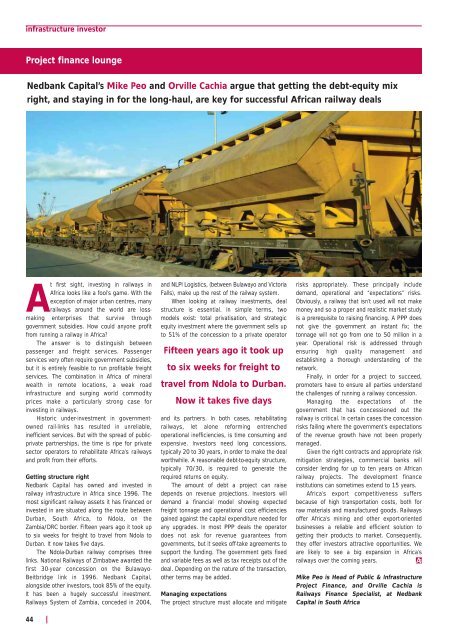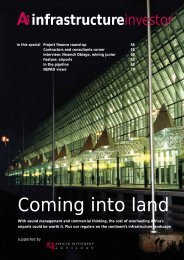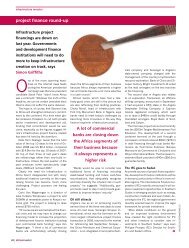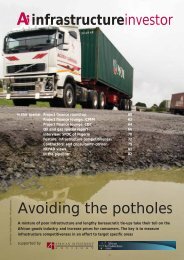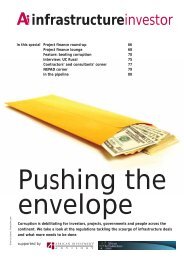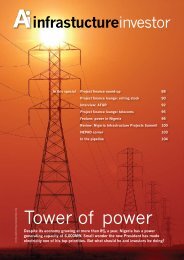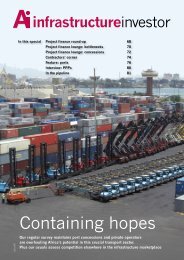Infrastructure investor March 200 - Simon Griffiths
Infrastructure investor March 200 - Simon Griffiths
Infrastructure investor March 200 - Simon Griffiths
Create successful ePaper yourself
Turn your PDF publications into a flip-book with our unique Google optimized e-Paper software.
infrastructure <strong>investor</strong>Project finance loungeNedbank Capital’s Mike Peo and Orville Cachia argue that getting the debt-equity mixright, and staying in for the long-haul, are key for successful African railway dealsAt first sight, investing in railways inAfrica looks like a fool’s game. With theexception of major urban centres, manyrailways around the world are lossmakingenterprises that survive throughgovernment subsidies. How could anyone profitfrom running a railway in Africa?The answer is to distinguish betweenpassenger and freight services. Passengerservices very often require government subsidies,but it is entirely feasible to run profitable freightservices. The combination in Africa of mineralwealth in remote locations, a weak roadinfrastructure and surging world commodityprices make a particularly strong case forinvesting in railways.Historic under-investment in governmentownedrail-links has resulted in unreliable,inefficient services. But with the spread of publicprivatepartnerships, the time is ripe for privatesector operators to rehabilitate Africa’s railwaysand profit from their efforts.Getting structure rightNedbank Capital has owned and invested inrailway infrastructure in Africa since 1996. Themost significant railway assets it has financed orinvested in are situated along the route betweenDurban, South Africa, to Ndola, on theZambia/DRC border. Fifteen years ago it took upto six weeks for freight to travel from Ndola toDurban. It now takes five days.The Ndola-Durban railway comprises threelinks. National Railways of Zimbabwe awarded thefirst 30-year concession on the Bulawayo-Beitbridge link in 1996. Nedbank Capital,alongside other <strong>investor</strong>s, took 85% of the equity.It has been a hugely successful investment.Railways System of Zambia, conceded in <strong>200</strong>4,and NLPI Logistics, (between Bulawayo and VictoriaFalls), make up the rest of the railway system.When looking at railway investments, dealstructure is essential. In simple terms, twomodels exist: total privatisation, and strategicequity investment where the government sells upto 51% of the concession to a private operatorFifteen years ago it took upto six weeks for freight totravel from Ndola to Durban.Now it takes five daysand its partners. In both cases, rehabilitatingrailways, let alone reforming entrenchedoperational inefficiencies, is time consuming andexpensive. Investors need long concessions,typically 20 to 30 years, in order to make the dealworthwhile. A reasonable debt-to-equity structure,typically 70/30, is required to generate therequired returns on equity.The amount of debt a project can raisedepends on revenue projections. Investors willdemand a financial model showing expectedfreight tonnage and operational cost efficienciesgained against the capital expenditure needed forany upgrades. In most PPP deals the operatordoes not ask for revenue guarantees fromgovernments, but it seeks off-take agreements tosupport the funding. The government gets fixedand variable fees as well as tax receipts out of thedeal. Depending on the nature of the transaction,other terms may be added.Managing expectationsThe project structure must allocate and mitigaterisks appropriately. These principally includedemand, operational and “expectations” risks.Obviously, a railway that isn’t used will not makemoney and so a proper and realistic market studyis a prerequisite to raising financing. A PPP doesnot give the government an instant fix; thetonnage will not go from one to 50 million in ayear. Operational risk is addressed throughensuring high quality management andestablishing a thorough understanding of thenetwork.Finally, in order for a project to succeed,promoters have to ensure all parties understandthe challenges of running a railway concession.Managing the expectations of thegovernment that has concessioned out therailway is critical. In certain cases the concessionrisks failing where the government’s expectationsof the revenue growth have not been properlymanaged.Given the right contracts and appropriate riskmitigation strategies, commercial banks willconsider lending for up to ten years on Africanrailway projects. The development financeinstitutions can sometimes extend to 15 years.Africa’s export competitiveness suffersbecause of high transportation costs, both forraw materials and manufactured goods. Railwaysoffer Africa’s mining and other export-orientedbusinesses a reliable and efficient solution togetting their products to market. Consequently,they offer <strong>investor</strong>s attractive opportunities. Weare likely to see a big expansion in Africa’srailways over the coming years.Mike Peo is Head of Public & <strong>Infrastructure</strong>Project Finance, and Orville Cachia isRailways Finance Specialist, at NedbankCapital in South Africa44


